Accounting Information Systems Report: Business Ethics and BI Impact
VerifiedAdded on 2022/12/21
|11
|2098
|59
Report
AI Summary
This report delves into the realm of Accounting Information Systems (AIS), addressing key aspects such as the growth and impact of Business Intelligence (BI) tools. It highlights the increasing trend of BI in the business environment, supported by statistical data illustrating its revenue growth and the adoption of various BI tools. The report explores the features of BI tools used for decision-making, including executive dashboards and interactive reports, and their roles in data analysis and information communication. Furthermore, the report examines the importance of ethical standards in business, using the Enron scandal as a case study to illustrate the consequences of unethical practices and poor accounting policies. It discusses the regulations, such as the Sarbanes-Oxley Act and ethical codes of conduct, implemented after the Enron scandal to improve financial market control and ethical practices. Overall, the report provides a comprehensive overview of AIS, emphasizing the significance of BI and ethical considerations in modern business operations.
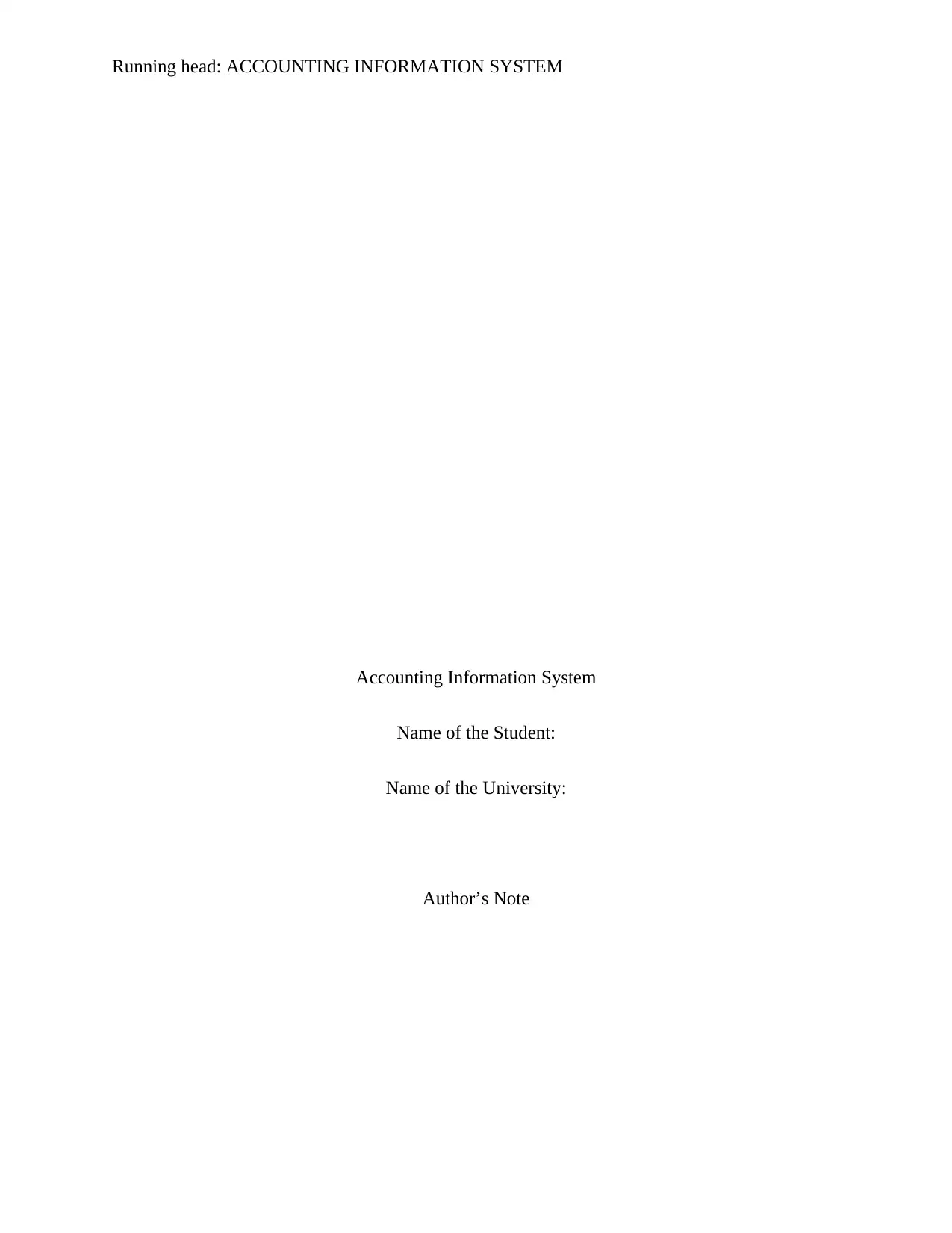
Running head: ACCOUNTING INFORMATION SYSTEM
Accounting Information System
Name of the Student:
Name of the University:
Author’s Note
Accounting Information System
Name of the Student:
Name of the University:
Author’s Note
Paraphrase This Document
Need a fresh take? Get an instant paraphrase of this document with our AI Paraphraser
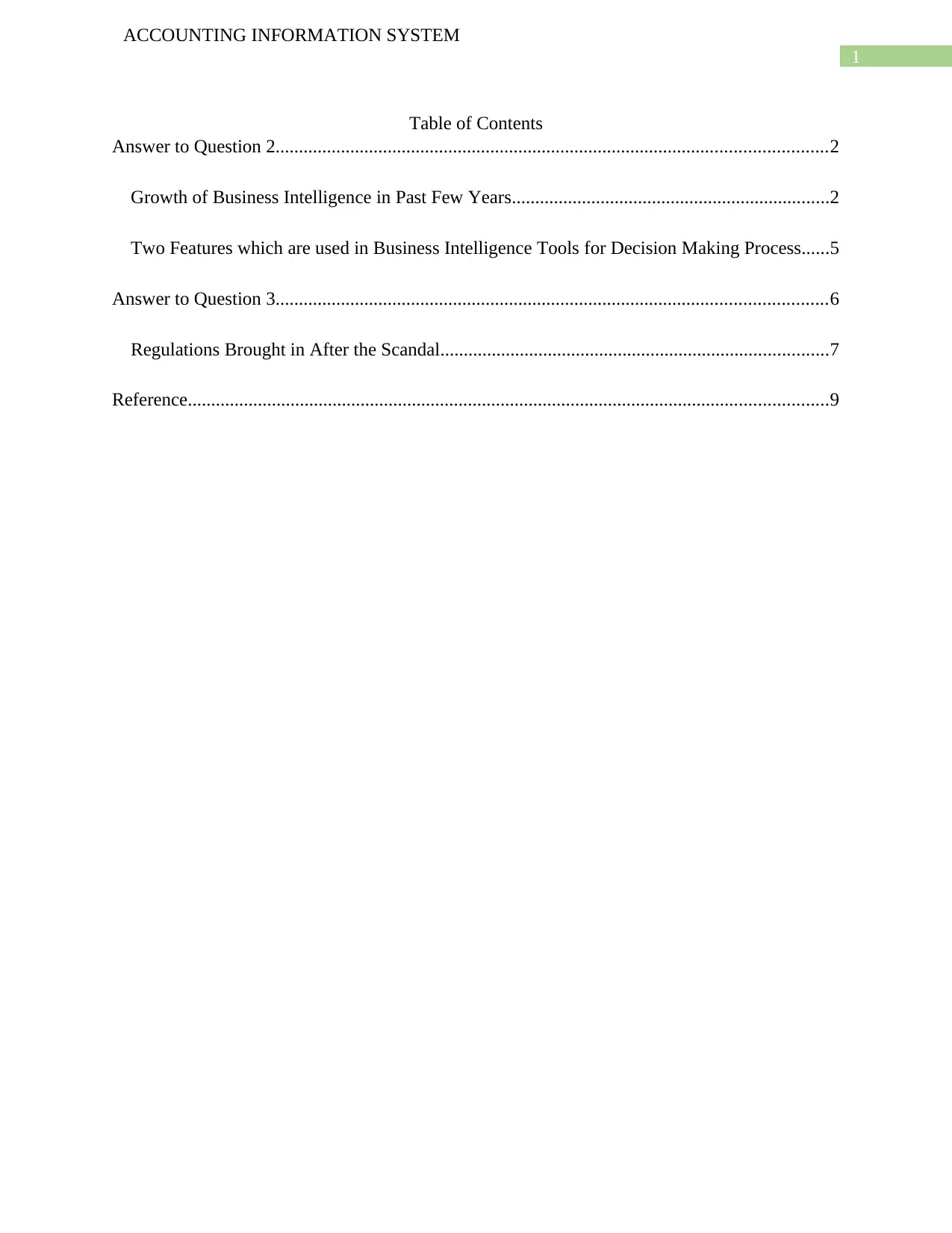
1
ACCOUNTING INFORMATION SYSTEM
Table of Contents
Answer to Question 2......................................................................................................................2
Growth of Business Intelligence in Past Few Years....................................................................2
Two Features which are used in Business Intelligence Tools for Decision Making Process......5
Answer to Question 3......................................................................................................................6
Regulations Brought in After the Scandal...................................................................................7
Reference.........................................................................................................................................9
ACCOUNTING INFORMATION SYSTEM
Table of Contents
Answer to Question 2......................................................................................................................2
Growth of Business Intelligence in Past Few Years....................................................................2
Two Features which are used in Business Intelligence Tools for Decision Making Process......5
Answer to Question 3......................................................................................................................6
Regulations Brought in After the Scandal...................................................................................7
Reference.........................................................................................................................................9
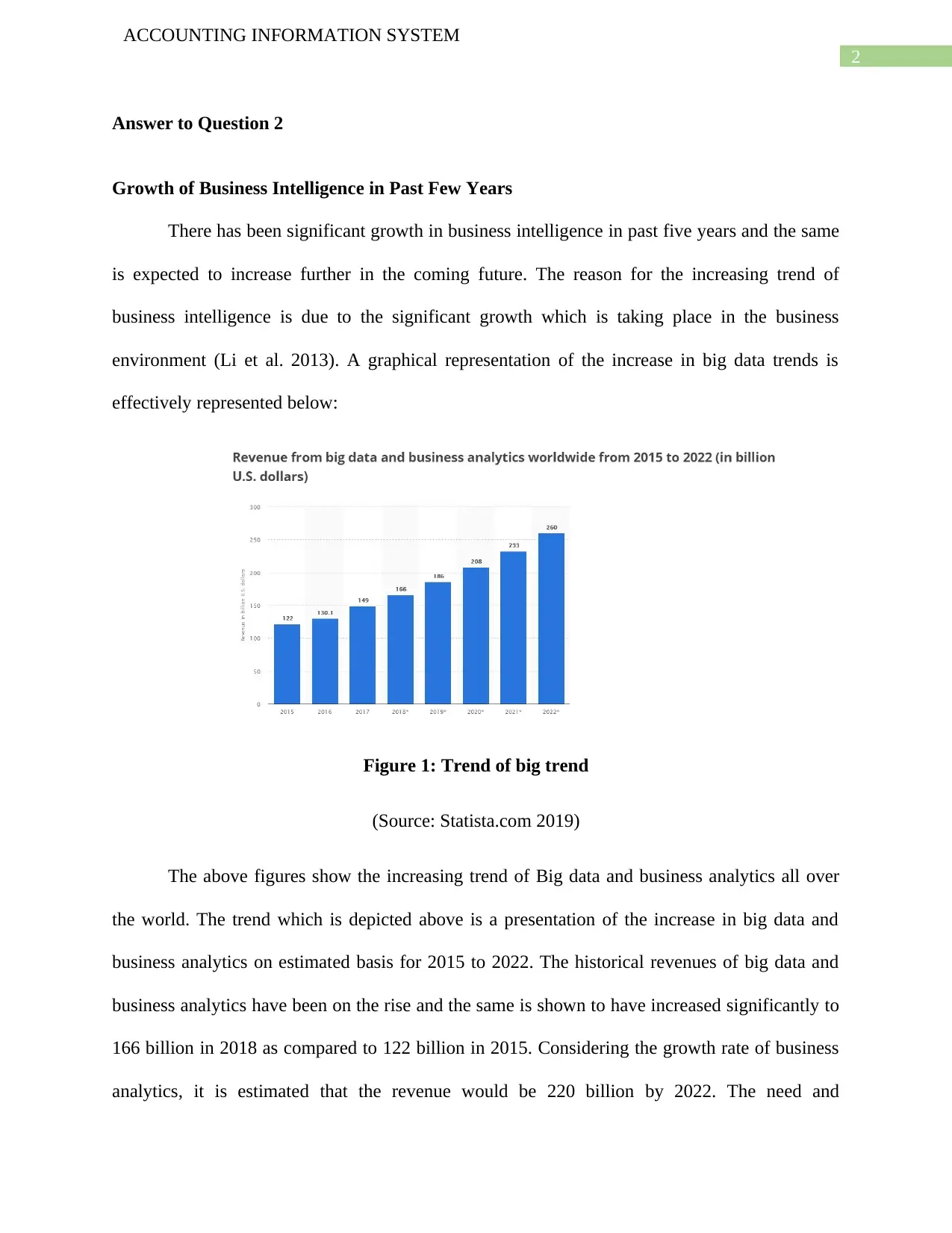
2
ACCOUNTING INFORMATION SYSTEM
Answer to Question 2
Growth of Business Intelligence in Past Few Years
There has been significant growth in business intelligence in past five years and the same
is expected to increase further in the coming future. The reason for the increasing trend of
business intelligence is due to the significant growth which is taking place in the business
environment (Li et al. 2013). A graphical representation of the increase in big data trends is
effectively represented below:
Figure 1: Trend of big trend
(Source: Statista.com 2019)
The above figures show the increasing trend of Big data and business analytics all over
the world. The trend which is depicted above is a presentation of the increase in big data and
business analytics on estimated basis for 2015 to 2022. The historical revenues of big data and
business analytics have been on the rise and the same is shown to have increased significantly to
166 billion in 2018 as compared to 122 billion in 2015. Considering the growth rate of business
analytics, it is estimated that the revenue would be 220 billion by 2022. The need and
ACCOUNTING INFORMATION SYSTEM
Answer to Question 2
Growth of Business Intelligence in Past Few Years
There has been significant growth in business intelligence in past five years and the same
is expected to increase further in the coming future. The reason for the increasing trend of
business intelligence is due to the significant growth which is taking place in the business
environment (Li et al. 2013). A graphical representation of the increase in big data trends is
effectively represented below:
Figure 1: Trend of big trend
(Source: Statista.com 2019)
The above figures show the increasing trend of Big data and business analytics all over
the world. The trend which is depicted above is a presentation of the increase in big data and
business analytics on estimated basis for 2015 to 2022. The historical revenues of big data and
business analytics have been on the rise and the same is shown to have increased significantly to
166 billion in 2018 as compared to 122 billion in 2015. Considering the growth rate of business
analytics, it is estimated that the revenue would be 220 billion by 2022. The need and
⊘ This is a preview!⊘
Do you want full access?
Subscribe today to unlock all pages.

Trusted by 1+ million students worldwide
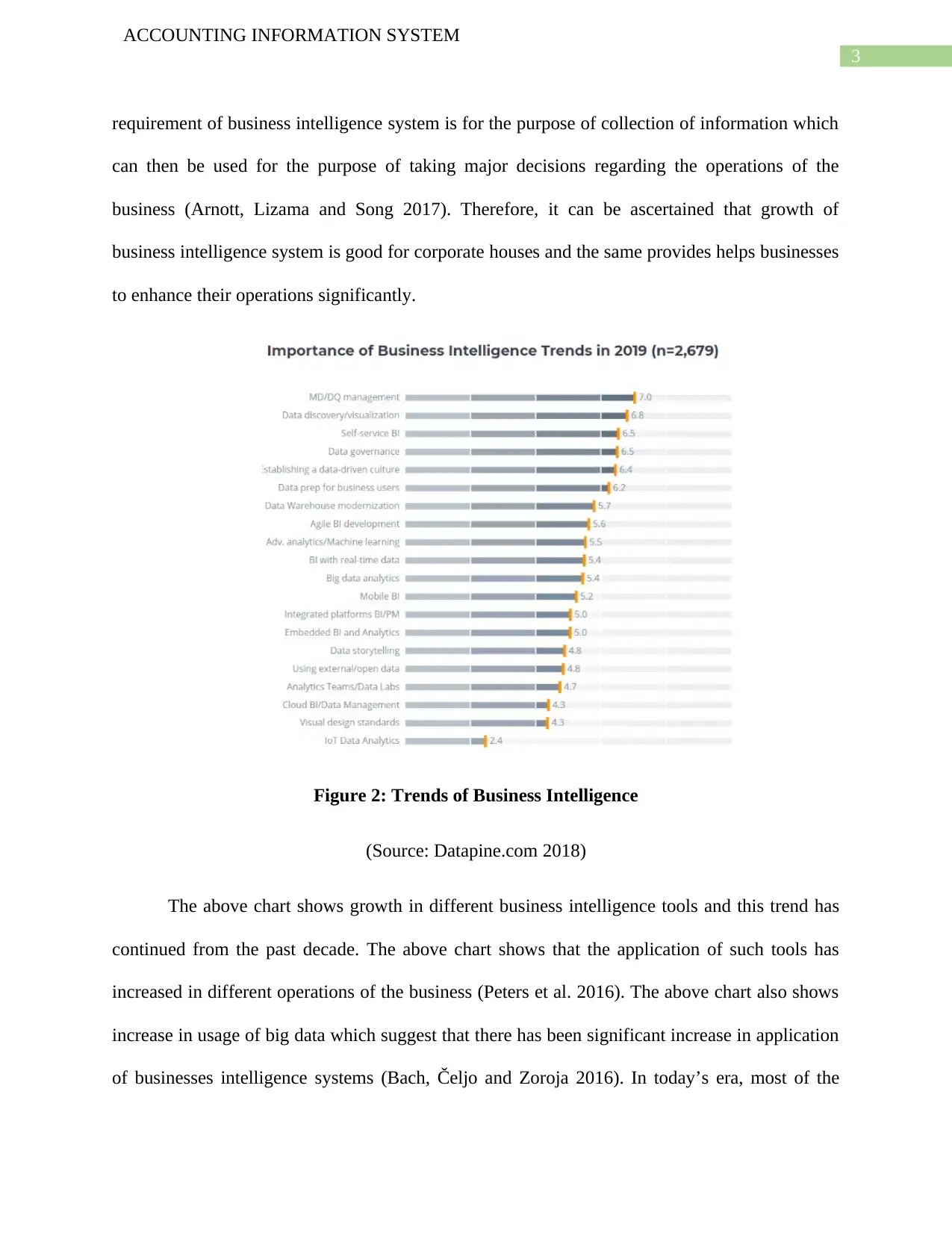
3
ACCOUNTING INFORMATION SYSTEM
requirement of business intelligence system is for the purpose of collection of information which
can then be used for the purpose of taking major decisions regarding the operations of the
business (Arnott, Lizama and Song 2017). Therefore, it can be ascertained that growth of
business intelligence system is good for corporate houses and the same provides helps businesses
to enhance their operations significantly.
Figure 2: Trends of Business Intelligence
(Source: Datapine.com 2018)
The above chart shows growth in different business intelligence tools and this trend has
continued from the past decade. The above chart shows that the application of such tools has
increased in different operations of the business (Peters et al. 2016). The above chart also shows
increase in usage of big data which suggest that there has been significant increase in application
of businesses intelligence systems (Bach, Čeljo and Zoroja 2016). In today’s era, most of the
ACCOUNTING INFORMATION SYSTEM
requirement of business intelligence system is for the purpose of collection of information which
can then be used for the purpose of taking major decisions regarding the operations of the
business (Arnott, Lizama and Song 2017). Therefore, it can be ascertained that growth of
business intelligence system is good for corporate houses and the same provides helps businesses
to enhance their operations significantly.
Figure 2: Trends of Business Intelligence
(Source: Datapine.com 2018)
The above chart shows growth in different business intelligence tools and this trend has
continued from the past decade. The above chart shows that the application of such tools has
increased in different operations of the business (Peters et al. 2016). The above chart also shows
increase in usage of big data which suggest that there has been significant increase in application
of businesses intelligence systems (Bach, Čeljo and Zoroja 2016). In today’s era, most of the
Paraphrase This Document
Need a fresh take? Get an instant paraphrase of this document with our AI Paraphraser
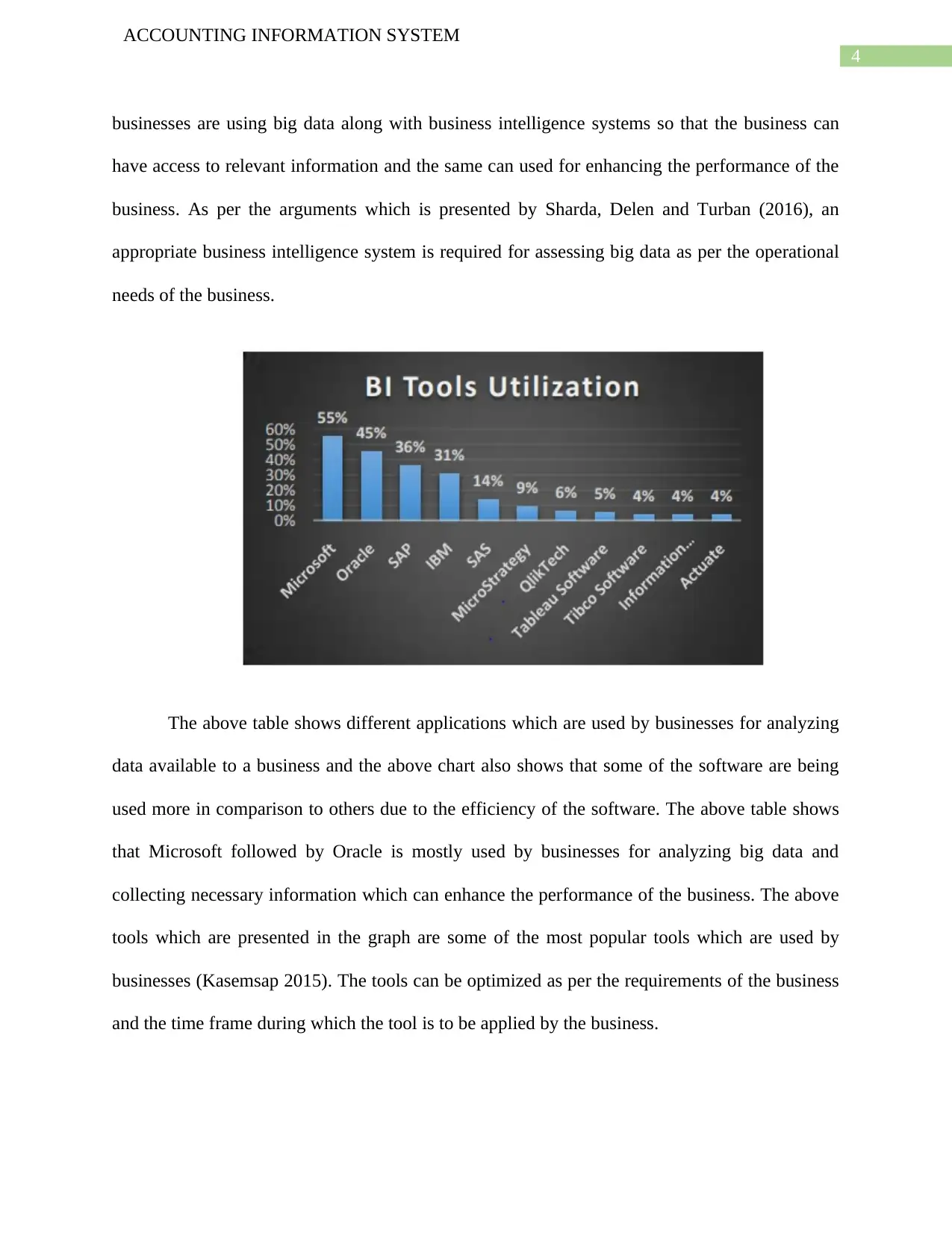
4
ACCOUNTING INFORMATION SYSTEM
businesses are using big data along with business intelligence systems so that the business can
have access to relevant information and the same can used for enhancing the performance of the
business. As per the arguments which is presented by Sharda, Delen and Turban (2016), an
appropriate business intelligence system is required for assessing big data as per the operational
needs of the business.
The above table shows different applications which are used by businesses for analyzing
data available to a business and the above chart also shows that some of the software are being
used more in comparison to others due to the efficiency of the software. The above table shows
that Microsoft followed by Oracle is mostly used by businesses for analyzing big data and
collecting necessary information which can enhance the performance of the business. The above
tools which are presented in the graph are some of the most popular tools which are used by
businesses (Kasemsap 2015). The tools can be optimized as per the requirements of the business
and the time frame during which the tool is to be applied by the business.
ACCOUNTING INFORMATION SYSTEM
businesses are using big data along with business intelligence systems so that the business can
have access to relevant information and the same can used for enhancing the performance of the
business. As per the arguments which is presented by Sharda, Delen and Turban (2016), an
appropriate business intelligence system is required for assessing big data as per the operational
needs of the business.
The above table shows different applications which are used by businesses for analyzing
data available to a business and the above chart also shows that some of the software are being
used more in comparison to others due to the efficiency of the software. The above table shows
that Microsoft followed by Oracle is mostly used by businesses for analyzing big data and
collecting necessary information which can enhance the performance of the business. The above
tools which are presented in the graph are some of the most popular tools which are used by
businesses (Kasemsap 2015). The tools can be optimized as per the requirements of the business
and the time frame during which the tool is to be applied by the business.
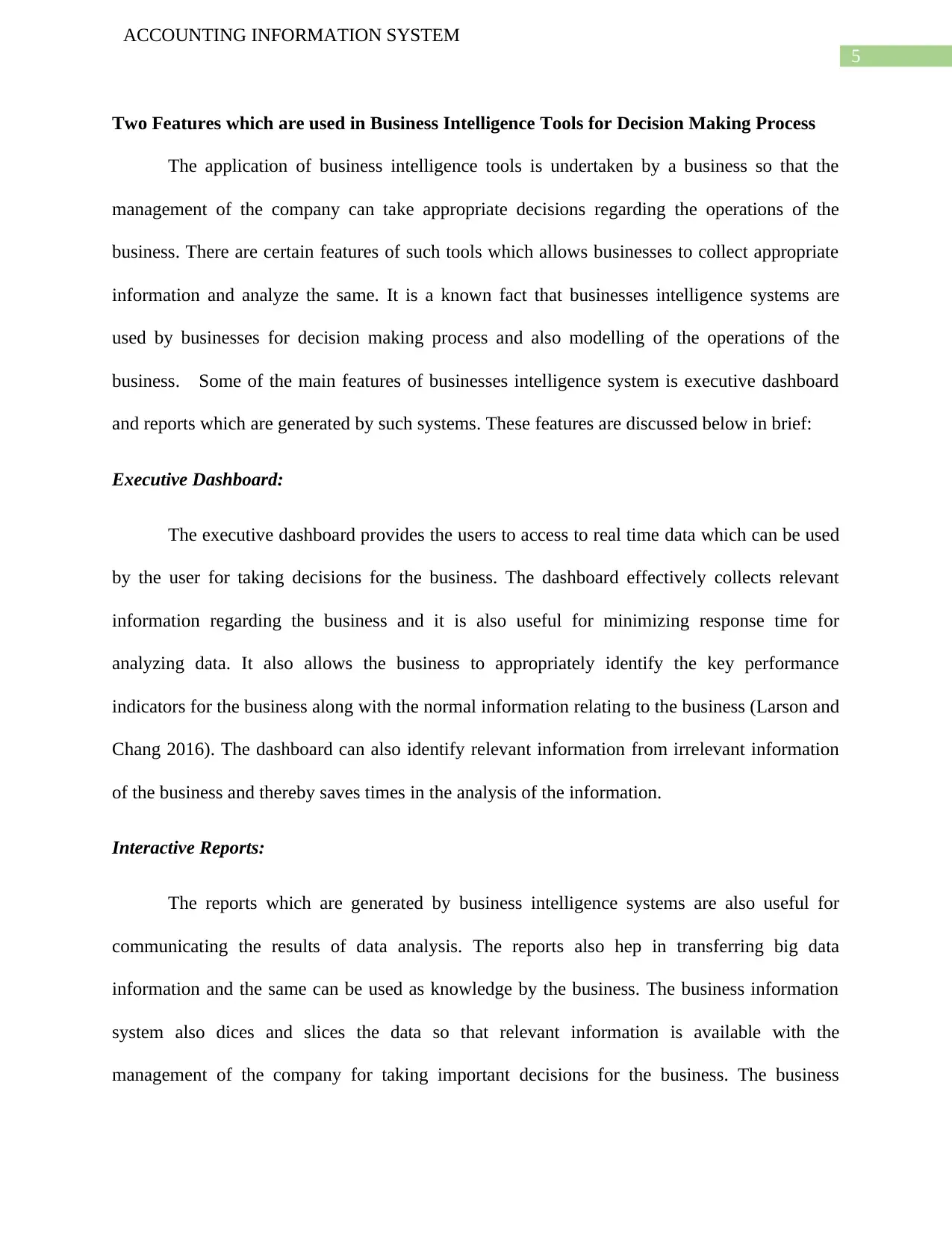
5
ACCOUNTING INFORMATION SYSTEM
Two Features which are used in Business Intelligence Tools for Decision Making Process
The application of business intelligence tools is undertaken by a business so that the
management of the company can take appropriate decisions regarding the operations of the
business. There are certain features of such tools which allows businesses to collect appropriate
information and analyze the same. It is a known fact that businesses intelligence systems are
used by businesses for decision making process and also modelling of the operations of the
business. Some of the main features of businesses intelligence system is executive dashboard
and reports which are generated by such systems. These features are discussed below in brief:
Executive Dashboard:
The executive dashboard provides the users to access to real time data which can be used
by the user for taking decisions for the business. The dashboard effectively collects relevant
information regarding the business and it is also useful for minimizing response time for
analyzing data. It also allows the business to appropriately identify the key performance
indicators for the business along with the normal information relating to the business (Larson and
Chang 2016). The dashboard can also identify relevant information from irrelevant information
of the business and thereby saves times in the analysis of the information.
Interactive Reports:
The reports which are generated by business intelligence systems are also useful for
communicating the results of data analysis. The reports also hep in transferring big data
information and the same can be used as knowledge by the business. The business information
system also dices and slices the data so that relevant information is available with the
management of the company for taking important decisions for the business. The business
ACCOUNTING INFORMATION SYSTEM
Two Features which are used in Business Intelligence Tools for Decision Making Process
The application of business intelligence tools is undertaken by a business so that the
management of the company can take appropriate decisions regarding the operations of the
business. There are certain features of such tools which allows businesses to collect appropriate
information and analyze the same. It is a known fact that businesses intelligence systems are
used by businesses for decision making process and also modelling of the operations of the
business. Some of the main features of businesses intelligence system is executive dashboard
and reports which are generated by such systems. These features are discussed below in brief:
Executive Dashboard:
The executive dashboard provides the users to access to real time data which can be used
by the user for taking decisions for the business. The dashboard effectively collects relevant
information regarding the business and it is also useful for minimizing response time for
analyzing data. It also allows the business to appropriately identify the key performance
indicators for the business along with the normal information relating to the business (Larson and
Chang 2016). The dashboard can also identify relevant information from irrelevant information
of the business and thereby saves times in the analysis of the information.
Interactive Reports:
The reports which are generated by business intelligence systems are also useful for
communicating the results of data analysis. The reports also hep in transferring big data
information and the same can be used as knowledge by the business. The business information
system also dices and slices the data so that relevant information is available with the
management of the company for taking important decisions for the business. The business
⊘ This is a preview!⊘
Do you want full access?
Subscribe today to unlock all pages.

Trusted by 1+ million students worldwide
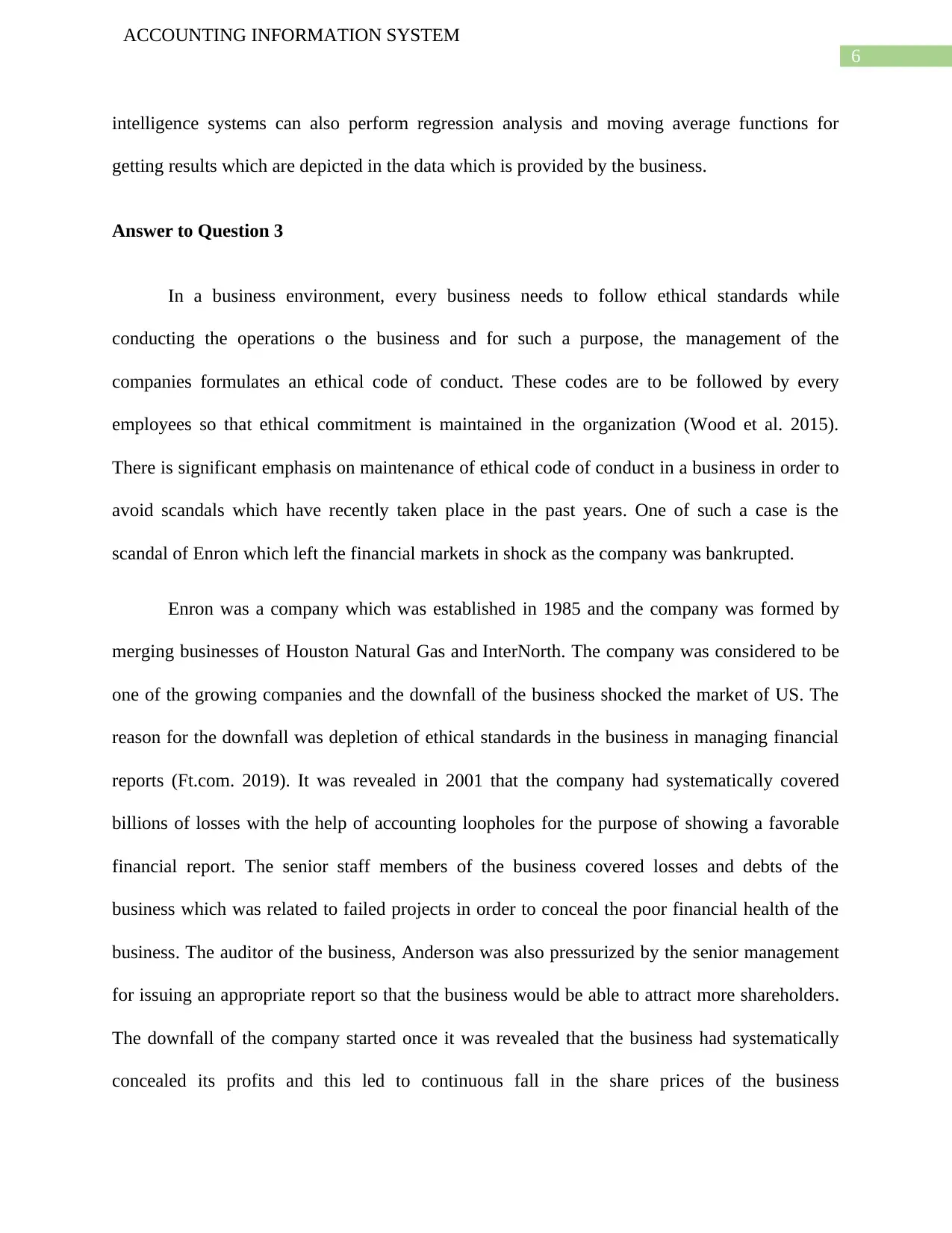
6
ACCOUNTING INFORMATION SYSTEM
intelligence systems can also perform regression analysis and moving average functions for
getting results which are depicted in the data which is provided by the business.
Answer to Question 3
In a business environment, every business needs to follow ethical standards while
conducting the operations o the business and for such a purpose, the management of the
companies formulates an ethical code of conduct. These codes are to be followed by every
employees so that ethical commitment is maintained in the organization (Wood et al. 2015).
There is significant emphasis on maintenance of ethical code of conduct in a business in order to
avoid scandals which have recently taken place in the past years. One of such a case is the
scandal of Enron which left the financial markets in shock as the company was bankrupted.
Enron was a company which was established in 1985 and the company was formed by
merging businesses of Houston Natural Gas and InterNorth. The company was considered to be
one of the growing companies and the downfall of the business shocked the market of US. The
reason for the downfall was depletion of ethical standards in the business in managing financial
reports (Ft.com. 2019). It was revealed in 2001 that the company had systematically covered
billions of losses with the help of accounting loopholes for the purpose of showing a favorable
financial report. The senior staff members of the business covered losses and debts of the
business which was related to failed projects in order to conceal the poor financial health of the
business. The auditor of the business, Anderson was also pressurized by the senior management
for issuing an appropriate report so that the business would be able to attract more shareholders.
The downfall of the company started once it was revealed that the business had systematically
concealed its profits and this led to continuous fall in the share prices of the business
ACCOUNTING INFORMATION SYSTEM
intelligence systems can also perform regression analysis and moving average functions for
getting results which are depicted in the data which is provided by the business.
Answer to Question 3
In a business environment, every business needs to follow ethical standards while
conducting the operations o the business and for such a purpose, the management of the
companies formulates an ethical code of conduct. These codes are to be followed by every
employees so that ethical commitment is maintained in the organization (Wood et al. 2015).
There is significant emphasis on maintenance of ethical code of conduct in a business in order to
avoid scandals which have recently taken place in the past years. One of such a case is the
scandal of Enron which left the financial markets in shock as the company was bankrupted.
Enron was a company which was established in 1985 and the company was formed by
merging businesses of Houston Natural Gas and InterNorth. The company was considered to be
one of the growing companies and the downfall of the business shocked the market of US. The
reason for the downfall was depletion of ethical standards in the business in managing financial
reports (Ft.com. 2019). It was revealed in 2001 that the company had systematically covered
billions of losses with the help of accounting loopholes for the purpose of showing a favorable
financial report. The senior staff members of the business covered losses and debts of the
business which was related to failed projects in order to conceal the poor financial health of the
business. The auditor of the business, Anderson was also pressurized by the senior management
for issuing an appropriate report so that the business would be able to attract more shareholders.
The downfall of the company started once it was revealed that the business had systematically
concealed its profits and this led to continuous fall in the share prices of the business
Paraphrase This Document
Need a fresh take? Get an instant paraphrase of this document with our AI Paraphraser
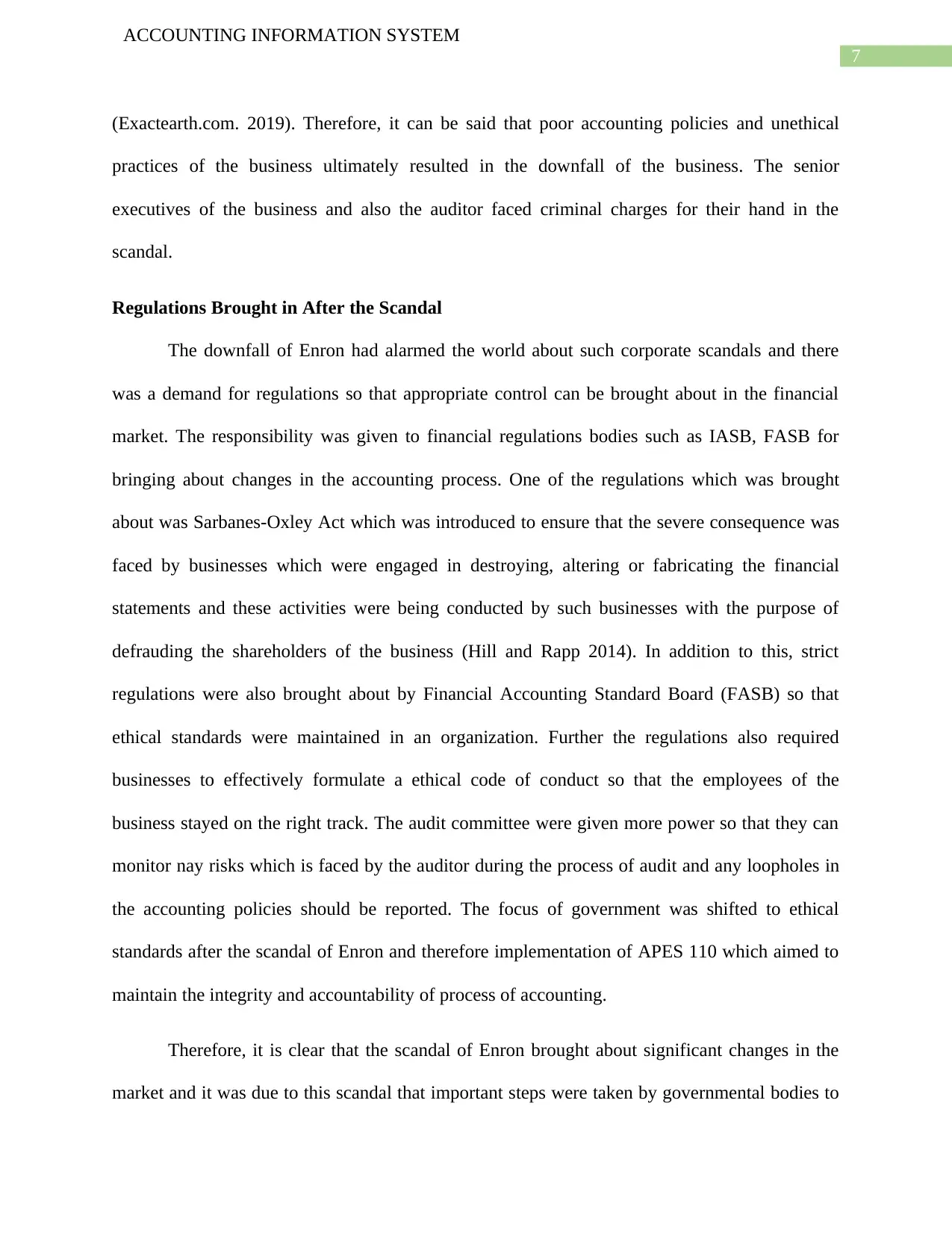
7
ACCOUNTING INFORMATION SYSTEM
(Exactearth.com. 2019). Therefore, it can be said that poor accounting policies and unethical
practices of the business ultimately resulted in the downfall of the business. The senior
executives of the business and also the auditor faced criminal charges for their hand in the
scandal.
Regulations Brought in After the Scandal
The downfall of Enron had alarmed the world about such corporate scandals and there
was a demand for regulations so that appropriate control can be brought about in the financial
market. The responsibility was given to financial regulations bodies such as IASB, FASB for
bringing about changes in the accounting process. One of the regulations which was brought
about was Sarbanes-Oxley Act which was introduced to ensure that the severe consequence was
faced by businesses which were engaged in destroying, altering or fabricating the financial
statements and these activities were being conducted by such businesses with the purpose of
defrauding the shareholders of the business (Hill and Rapp 2014). In addition to this, strict
regulations were also brought about by Financial Accounting Standard Board (FASB) so that
ethical standards were maintained in an organization. Further the regulations also required
businesses to effectively formulate a ethical code of conduct so that the employees of the
business stayed on the right track. The audit committee were given more power so that they can
monitor nay risks which is faced by the auditor during the process of audit and any loopholes in
the accounting policies should be reported. The focus of government was shifted to ethical
standards after the scandal of Enron and therefore implementation of APES 110 which aimed to
maintain the integrity and accountability of process of accounting.
Therefore, it is clear that the scandal of Enron brought about significant changes in the
market and it was due to this scandal that important steps were taken by governmental bodies to
ACCOUNTING INFORMATION SYSTEM
(Exactearth.com. 2019). Therefore, it can be said that poor accounting policies and unethical
practices of the business ultimately resulted in the downfall of the business. The senior
executives of the business and also the auditor faced criminal charges for their hand in the
scandal.
Regulations Brought in After the Scandal
The downfall of Enron had alarmed the world about such corporate scandals and there
was a demand for regulations so that appropriate control can be brought about in the financial
market. The responsibility was given to financial regulations bodies such as IASB, FASB for
bringing about changes in the accounting process. One of the regulations which was brought
about was Sarbanes-Oxley Act which was introduced to ensure that the severe consequence was
faced by businesses which were engaged in destroying, altering or fabricating the financial
statements and these activities were being conducted by such businesses with the purpose of
defrauding the shareholders of the business (Hill and Rapp 2014). In addition to this, strict
regulations were also brought about by Financial Accounting Standard Board (FASB) so that
ethical standards were maintained in an organization. Further the regulations also required
businesses to effectively formulate a ethical code of conduct so that the employees of the
business stayed on the right track. The audit committee were given more power so that they can
monitor nay risks which is faced by the auditor during the process of audit and any loopholes in
the accounting policies should be reported. The focus of government was shifted to ethical
standards after the scandal of Enron and therefore implementation of APES 110 which aimed to
maintain the integrity and accountability of process of accounting.
Therefore, it is clear that the scandal of Enron brought about significant changes in the
market and it was due to this scandal that important steps were taken by governmental bodies to
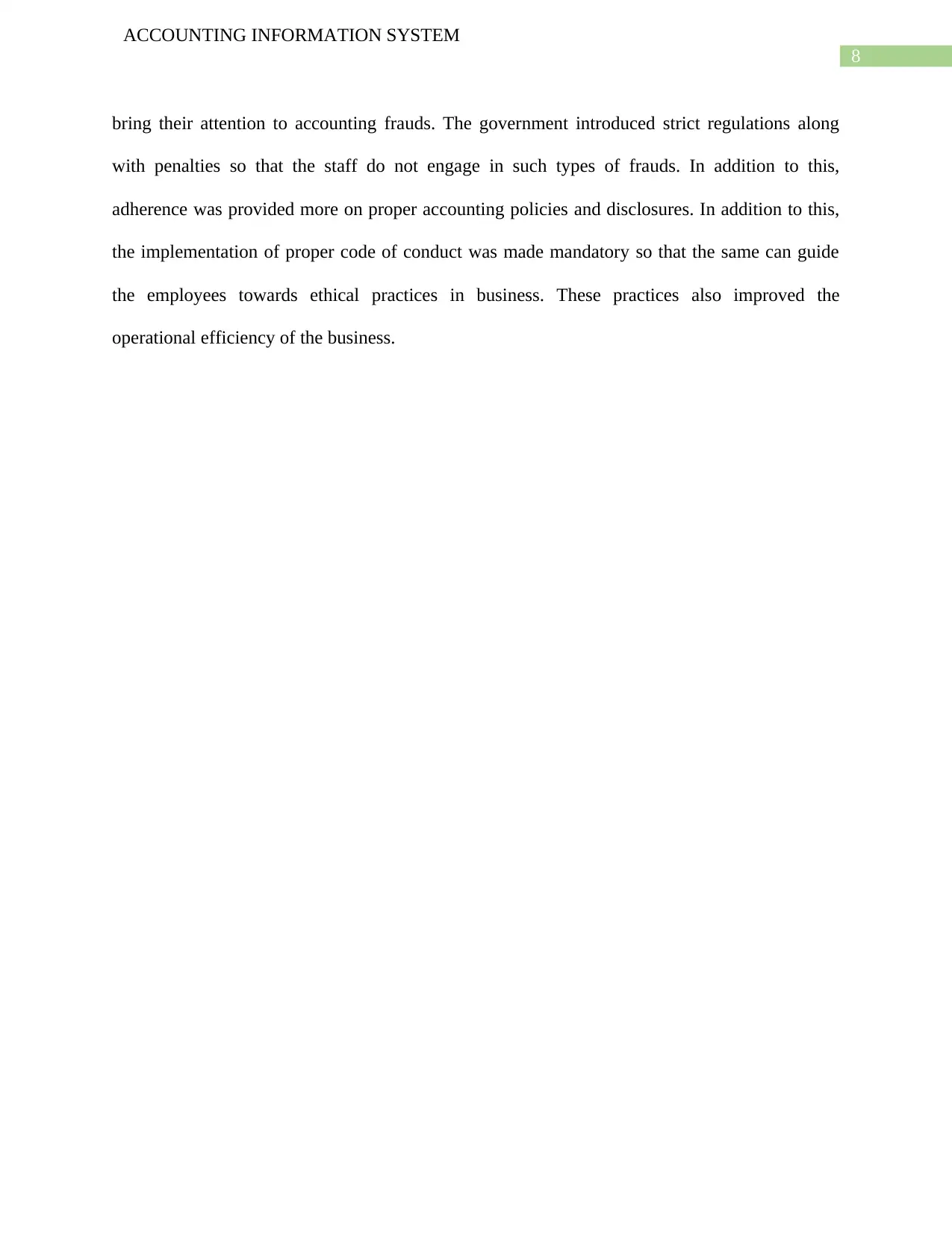
8
ACCOUNTING INFORMATION SYSTEM
bring their attention to accounting frauds. The government introduced strict regulations along
with penalties so that the staff do not engage in such types of frauds. In addition to this,
adherence was provided more on proper accounting policies and disclosures. In addition to this,
the implementation of proper code of conduct was made mandatory so that the same can guide
the employees towards ethical practices in business. These practices also improved the
operational efficiency of the business.
ACCOUNTING INFORMATION SYSTEM
bring their attention to accounting frauds. The government introduced strict regulations along
with penalties so that the staff do not engage in such types of frauds. In addition to this,
adherence was provided more on proper accounting policies and disclosures. In addition to this,
the implementation of proper code of conduct was made mandatory so that the same can guide
the employees towards ethical practices in business. These practices also improved the
operational efficiency of the business.
⊘ This is a preview!⊘
Do you want full access?
Subscribe today to unlock all pages.

Trusted by 1+ million students worldwide
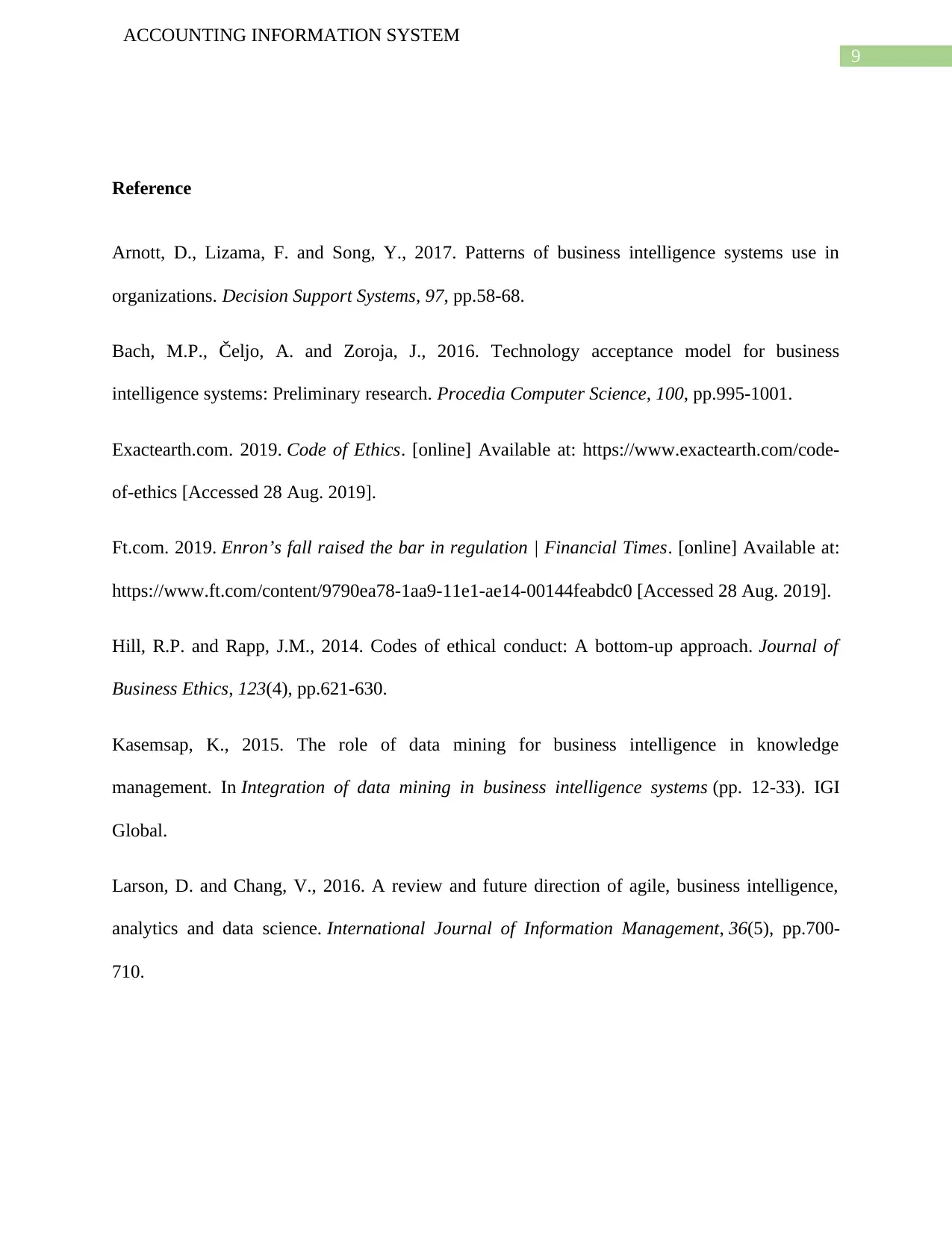
9
ACCOUNTING INFORMATION SYSTEM
Reference
Arnott, D., Lizama, F. and Song, Y., 2017. Patterns of business intelligence systems use in
organizations. Decision Support Systems, 97, pp.58-68.
Bach, M.P., Čeljo, A. and Zoroja, J., 2016. Technology acceptance model for business
intelligence systems: Preliminary research. Procedia Computer Science, 100, pp.995-1001.
Exactearth.com. 2019. Code of Ethics. [online] Available at: https://www.exactearth.com/code-
of-ethics [Accessed 28 Aug. 2019].
Ft.com. 2019. Enron’s fall raised the bar in regulation | Financial Times. [online] Available at:
https://www.ft.com/content/9790ea78-1aa9-11e1-ae14-00144feabdc0 [Accessed 28 Aug. 2019].
Hill, R.P. and Rapp, J.M., 2014. Codes of ethical conduct: A bottom-up approach. Journal of
Business Ethics, 123(4), pp.621-630.
Kasemsap, K., 2015. The role of data mining for business intelligence in knowledge
management. In Integration of data mining in business intelligence systems (pp. 12-33). IGI
Global.
Larson, D. and Chang, V., 2016. A review and future direction of agile, business intelligence,
analytics and data science. International Journal of Information Management, 36(5), pp.700-
710.
ACCOUNTING INFORMATION SYSTEM
Reference
Arnott, D., Lizama, F. and Song, Y., 2017. Patterns of business intelligence systems use in
organizations. Decision Support Systems, 97, pp.58-68.
Bach, M.P., Čeljo, A. and Zoroja, J., 2016. Technology acceptance model for business
intelligence systems: Preliminary research. Procedia Computer Science, 100, pp.995-1001.
Exactearth.com. 2019. Code of Ethics. [online] Available at: https://www.exactearth.com/code-
of-ethics [Accessed 28 Aug. 2019].
Ft.com. 2019. Enron’s fall raised the bar in regulation | Financial Times. [online] Available at:
https://www.ft.com/content/9790ea78-1aa9-11e1-ae14-00144feabdc0 [Accessed 28 Aug. 2019].
Hill, R.P. and Rapp, J.M., 2014. Codes of ethical conduct: A bottom-up approach. Journal of
Business Ethics, 123(4), pp.621-630.
Kasemsap, K., 2015. The role of data mining for business intelligence in knowledge
management. In Integration of data mining in business intelligence systems (pp. 12-33). IGI
Global.
Larson, D. and Chang, V., 2016. A review and future direction of agile, business intelligence,
analytics and data science. International Journal of Information Management, 36(5), pp.700-
710.
Paraphrase This Document
Need a fresh take? Get an instant paraphrase of this document with our AI Paraphraser
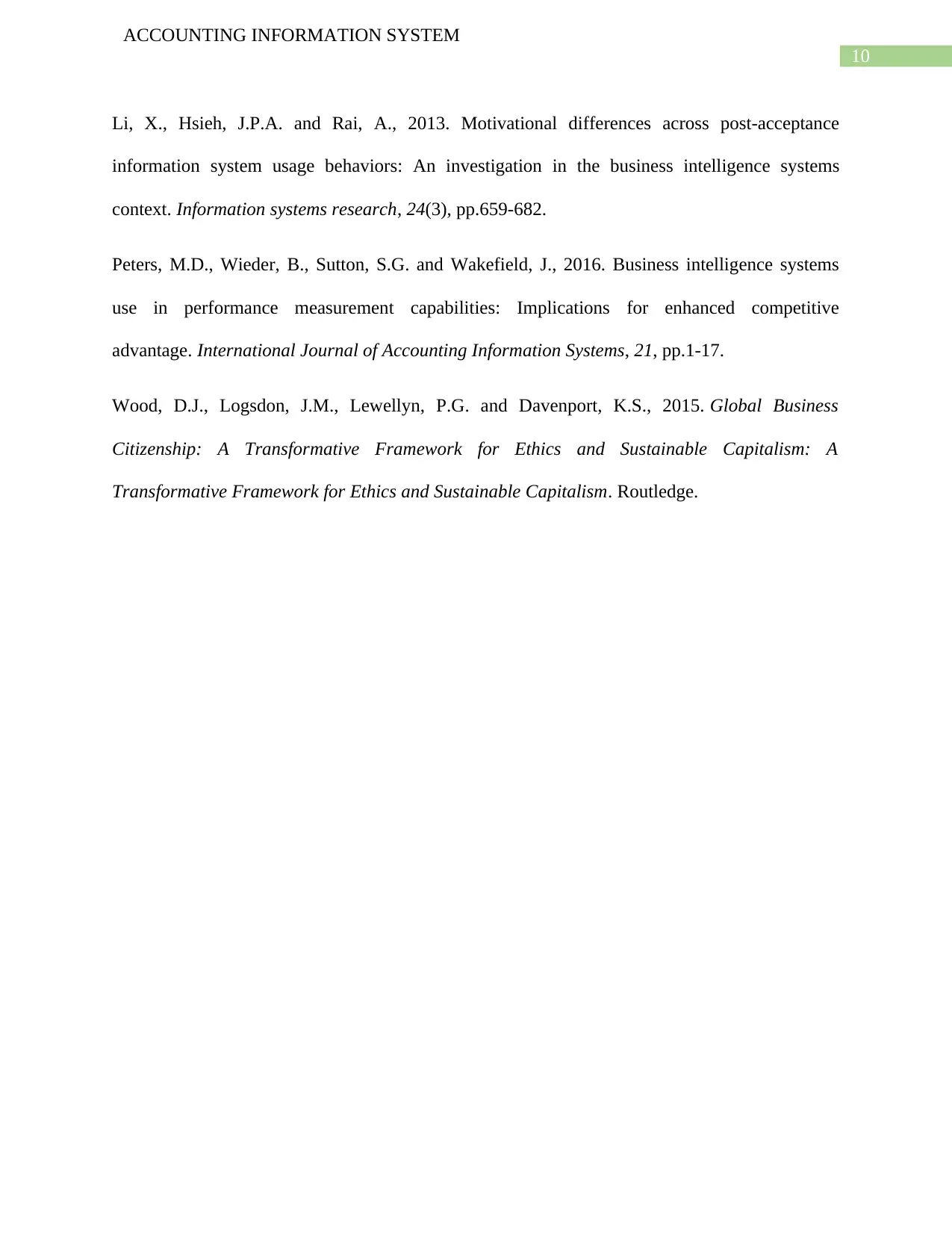
10
ACCOUNTING INFORMATION SYSTEM
Li, X., Hsieh, J.P.A. and Rai, A., 2013. Motivational differences across post-acceptance
information system usage behaviors: An investigation in the business intelligence systems
context. Information systems research, 24(3), pp.659-682.
Peters, M.D., Wieder, B., Sutton, S.G. and Wakefield, J., 2016. Business intelligence systems
use in performance measurement capabilities: Implications for enhanced competitive
advantage. International Journal of Accounting Information Systems, 21, pp.1-17.
Wood, D.J., Logsdon, J.M., Lewellyn, P.G. and Davenport, K.S., 2015. Global Business
Citizenship: A Transformative Framework for Ethics and Sustainable Capitalism: A
Transformative Framework for Ethics and Sustainable Capitalism. Routledge.
ACCOUNTING INFORMATION SYSTEM
Li, X., Hsieh, J.P.A. and Rai, A., 2013. Motivational differences across post-acceptance
information system usage behaviors: An investigation in the business intelligence systems
context. Information systems research, 24(3), pp.659-682.
Peters, M.D., Wieder, B., Sutton, S.G. and Wakefield, J., 2016. Business intelligence systems
use in performance measurement capabilities: Implications for enhanced competitive
advantage. International Journal of Accounting Information Systems, 21, pp.1-17.
Wood, D.J., Logsdon, J.M., Lewellyn, P.G. and Davenport, K.S., 2015. Global Business
Citizenship: A Transformative Framework for Ethics and Sustainable Capitalism: A
Transformative Framework for Ethics and Sustainable Capitalism. Routledge.
1 out of 11
Related Documents
Your All-in-One AI-Powered Toolkit for Academic Success.
+13062052269
info@desklib.com
Available 24*7 on WhatsApp / Email
![[object Object]](/_next/static/media/star-bottom.7253800d.svg)
Unlock your academic potential
Copyright © 2020–2025 A2Z Services. All Rights Reserved. Developed and managed by ZUCOL.




